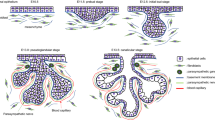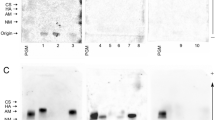Summary
The glycosaminoglycans (GAG) biosynthesized by a neoplastic human salivary duct cell line, HSGc, and by its nontumorigenic subclone, HSGc-E1, having a myoepithelial-like phenotype, were examined by incorporation of [3H]-acetate into GAG. The rate of GAG radiolabeling in HSGc-E1 was significantly greater than that in HSGc. The radiolabeled GAG recovered from HSGc-E1 showed a distribution of 22–32% in the cells and 68–78% secreted into the medium, while the amounts of GAG in the cells and medium of HSGc were equal. Two-dimensional electrophoresis of GAG extracted from the cells demonstrated that HSGc-E1 contained a much greater amount of heparan sulfate (HS, 53.5% of total), while HSGc synthesized hyaluronic acid (HA, 17.5%), HS 38.8%, chondroitin sulfate (Ch-S, 27.6%) and dermatan sulfate (DS, 16.1%). Moreover, treatment of HSGc with sodium butyrate or dibutyryl cyclic AMP (each is a potent inducer of differentiation to myoepithelial-like cells) strongly enhanced GAG synthesis, while dexamethasone (an inducer of differentiation to a more functional duct epithelium) did not stimulate GAG synthesis. These findings suggest that biosynthetic changes in the GAG content of neoplastic salivary cells are associated with their myoepithelial differentiation.
Similar content being viewed by others
References
Azzopardi JG, Smith OD (1959) Salivary gland tumours and their mucins. J Pathol Bacteriol 77:131–140
Azuma M, Hayashi Y, Yoshida H, Yanagawa T, Yura Y, Ueno A, Sato M (1986) Emergence of differentiated subclones from a human salivary gland adenocarcinoma cell clone in culture after treatment with sodium butyrate. Cancer Res 46:770–777
Bloom GD, Carlsoo B, Gustafson H, Henricksson R (1977) Distribution of mucosubstances in adenoid cystic carcinoma. Virchows Arch [Pathol Anat] 375:1–12
David R, Buchner A (1980) Elastosis in benign and malignant salivary gland tumors. A histochemical and ultrastructural study. Cancer 45:2301–2310
Doyle LE, Lynn JA, Panopio IT, Crass G (1968) Ultrastracture of the chondroid regions of benigh mixed tumor of salivary gland. Cancer 22:225–233
Evans RW, Cruickshank AH (1970) Epithelial tumors of the salivary glands. WB Saunders, Philadelphia p 209–226
Hatakeyama S, Kurokawa R, Satoh M, Suzuki A, Ota M, Shirasuna K (1987) Glucocorticoid-induced growth inhibition of human neoplastic salivary gland duct cell line (HSG). Acta Pathol. Jpn. 37:587–595
Hatakeyama S, Sashima M, Shirasuna K, Satoh M, Suzuki A, (1988) Glucocorticoid-induced growth inhibition with enhanced expression of ductal epithelium of human salivary gland adenocarcinoma cells transplanted into athymic nude mice. Cancer 62:716–722
Hübner G, Klein H, Kleinsasser O, Schiefer HG (1971) Role of myoepithelial cells in development of salivary gland tumors. Cancer 27:1255–1261
Kundson W, Biswas C, Toole BP (1984) Interaction between human tumor cells and fibroblasts stimulate hyaluronate synthesis. Proc Natl Acad Sci USA 81:6767–6771
Lovell D, Briggs JC, Schorah CJ (1966) Chemical analysis of acid mucopolysaccharides of mixed salivary tumours. Brit J Cancer 20:463–468
Mylius EA (1960) The identification and role of the myoepithelial cell in salivary gland tumours. Acta Pathol Microbiol Scand 50 (suppl. 139) 1–50
Quintarelli G, Robinson L (1967) The glycosaminoglycans of salivary gland tumours. Am J Pathol 51:1–32
Roblin R, Albert SO, Gelb NA, Black PH (1975) Cell surface changes correlated with density-dependent growth inhibition. Glycosaminoglycan metabolism in 3T3, SV3T3, and Con A selected revertant cells. Biochemistry 14:347–357
Shirasuna K, Sato M, Miyazaki T (1980) A myoepithelial cell line established from a human pleomorphic adenoma arising in minor salivary gland. Cancer 45:297–305
Shirasuna K, Sato M, Miyazaki T (1981) A neoplastic epithelial duct cell line established from an irradiated human salivary gland. Cancer 48:745–752
Shirasuna K, Watatani K, Sugiyama M, Morioka S, Miyazaki T (1986a) Isolation and characterization of different clones including myoepithelial-like variants from a clonal neoplastic epithelial duct cell line of human salivary gland origin. Cancer Res 46:1418–1426
Shirasuna K, Morioka S, Watatani K, Sugiyama M (1986 b) Different expression of alkaline phosphatase in subclones of human neoplastic salivary duct cell line. Biochem Biophys Res Comm 138:625–630
Shirasuna K, Morioka S, Watatani K, Hayashido Y, Furusawa H, Sugiyama M, Okura M, Matsuya T (1988) Growth inhibition and differentiation of human salivary adenocarcinoma cells by conditioned medium with normal human fibroblast. Cancer Res 48:2819–2824
Takeuchi J, Sobue M, Yoshida M, Esaki T, Katoh Y (1975) Pleomorphic adenoma of the salivary gland, with special reference to histochemical and electron microscopic studies and biochemical analysis of glycosaminoglycans in vivo and in vitro. Cancer 36:1771–1784
Takeuchi J, Sobue M, Katoh Y, Esaki T, Yoshida M, Miura K (1976) Morphologic and biologic characterizations of adenoid cystic carcinoma cells of the salvary gland. Cancer 38:2349–2356
Vannucchi S, Chiarugi VP (1976) Surface exposure of glycosaminoglycans in resting, growing and virus transformed 3T3 cells. J Cell Physiol 90:503–510
Yoshida H, Azuma M, Yanagawa T, Yura Y, Hayashi Y, Sato M (1986) Effect of dibutyryl cyclic AMP on morphologic features and biologic markers of a human salivary gland adenocarcinoma cell in culture. Cancer 57:1011–1018
Author information
Authors and Affiliations
Rights and permissions
About this article
Cite this article
Shirasuna, K., Furusawa, H., Morioka, S. et al. Different contents of glycosaminoglycans in a human neoplastic salivary duct cell line and its subclone with a myoepithelial phenotype. Virchows Archiv B Cell Pathol 57, 175–180 (1989). https://doi.org/10.1007/BF02899079
Received:
Accepted:
Issue Date:
DOI: https://doi.org/10.1007/BF02899079




